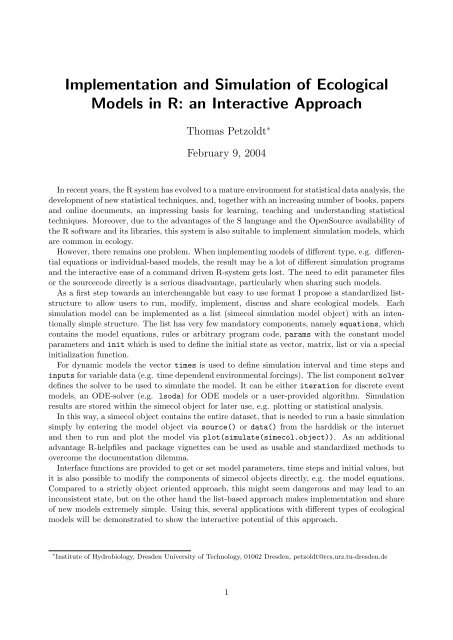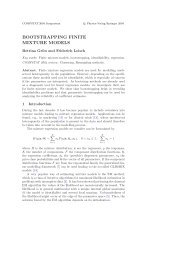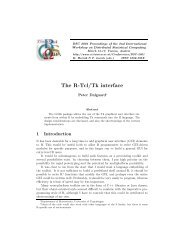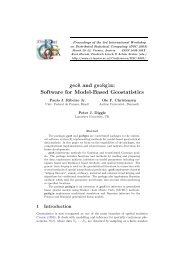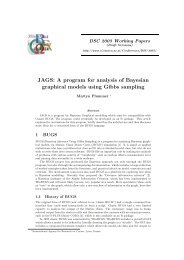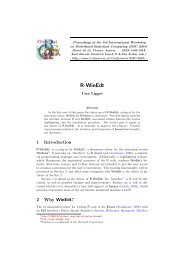Embedding R in Windows applications, and executing R remotely
Embedding R in Windows applications, and executing R remotely
Embedding R in Windows applications, and executing R remotely
Create successful ePaper yourself
Turn your PDF publications into a flip-book with our unique Google optimized e-Paper software.
Implementation <strong>and</strong> Simulation of Ecological<br />
Models <strong>in</strong> R: an Interactive Approach<br />
Thomas Petzoldt ∗<br />
February 9, 2004<br />
In recent years, the R system has evolved to a mature environment for statistical data analysis, the<br />
development of new statistical techniques, <strong>and</strong>, together with an <strong>in</strong>creas<strong>in</strong>g number of books, papers<br />
<strong>and</strong> onl<strong>in</strong>e documents, an impress<strong>in</strong>g basis for learn<strong>in</strong>g, teach<strong>in</strong>g <strong>and</strong> underst<strong>and</strong><strong>in</strong>g statistical<br />
techniques. Moreover, due to the advantages of the S language <strong>and</strong> the OpenSource availability of<br />
the R software <strong>and</strong> its libraries, this system is also suitable to implement simulation models, which<br />
are common <strong>in</strong> ecology.<br />
However, there rema<strong>in</strong>s one problem. When implement<strong>in</strong>g models of different type, e.g. differential<br />
equations or <strong>in</strong>dividual-based models, the result may be a lot of different simulation programs<br />
<strong>and</strong> the <strong>in</strong>teractive ease of a comm<strong>and</strong> driven R-system gets lost. The need to edit parameter files<br />
or the sourcecode directly is a serious disadvantage, particularly when shar<strong>in</strong>g such models.<br />
As a first step towards an <strong>in</strong>tercheangable but easy to use format I propose a st<strong>and</strong>ardized liststructure<br />
to allow users to run, modify, implement, discuss <strong>and</strong> share ecological models. Each<br />
simulation model can be implemented as a list (simecol simulation model object) with an <strong>in</strong>tentionally<br />
simple structure. The list has very few m<strong>and</strong>atory components, namely equations, which<br />
conta<strong>in</strong>s the model equations, rules or arbitrary program code, params with the constant model<br />
parameters <strong>and</strong> <strong>in</strong>it which is used to def<strong>in</strong>e the <strong>in</strong>itial state as vector, matrix, list or via a special<br />
<strong>in</strong>itialization function.<br />
For dynamic models the vector times is used to def<strong>in</strong>e simulation <strong>in</strong>terval <strong>and</strong> time steps <strong>and</strong><br />
<strong>in</strong>puts for variable data (e.g. time dependend environmental forc<strong>in</strong>gs). The list component solver<br />
def<strong>in</strong>es the solver to be used to simulate the model. It can be either iteration for discrete event<br />
models, an ODE-solver (e.g. lsoda) for ODE models or a user-provided algorithm. Simulation<br />
results are stored with<strong>in</strong> the simecol object for later use, e.g. plott<strong>in</strong>g or statistical analysis.<br />
In this way, a simecol object conta<strong>in</strong>s the entire dataset, that is needed to run a basic simulation<br />
simply by enter<strong>in</strong>g the model object via source() or data() from the harddisk or the <strong>in</strong>ternet<br />
<strong>and</strong> then to run <strong>and</strong> plot the model via plot(simulate(simecol.object)). As an additional<br />
advantage R-helpfiles <strong>and</strong> package vignettes can be used as usable <strong>and</strong> st<strong>and</strong>ardized methods to<br />
overcome the documentation dilemma.<br />
Interface functions are provided to get or set model parameters, time steps <strong>and</strong> <strong>in</strong>itial values, but<br />
it is also possible to modify the components of simecol objects directly, e.g. the model equations.<br />
Compared to a strictly object oriented approach, this might seem dangerous <strong>and</strong> may lead to an<br />
<strong>in</strong>consistent state, but on the other h<strong>and</strong> the list-based approach makes implementation <strong>and</strong> share<br />
of new models extremely simple. Us<strong>in</strong>g this, several <strong>applications</strong> with different types of ecological<br />
models will be demonstrated to show the <strong>in</strong>teractive potential of this approach.<br />
∗ Institute of Hydrobiology, Dresden University of Technology, 01062 Dresden, petzoldt@rcs.urz.tu-dresden.de<br />
1


